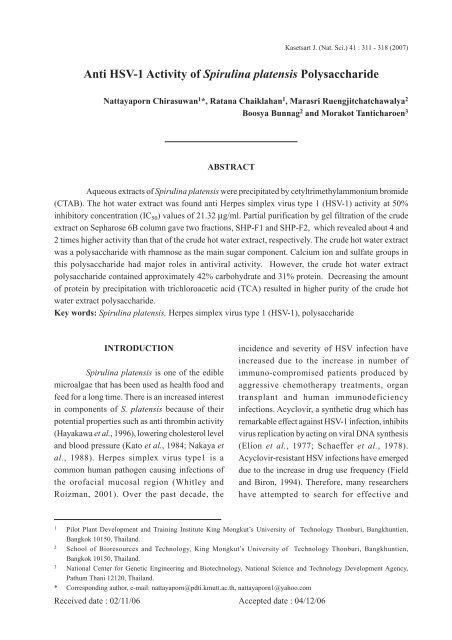April - June 2007 - Kasetsart University
April - June 2007 - Kasetsart University
April - June 2007 - Kasetsart University
Create successful ePaper yourself
Turn your PDF publications into a flip-book with our unique Google optimized e-Paper software.
<strong>Kasetsart</strong> J. (Nat. Sci.) 41 : 311 - 318 (<strong>2007</strong>)<br />
Anti HSV-1 Activity of Spirulina platensis Polysaccharide<br />
Nattayaporn Chirasuwan 1 *, Ratana Chaiklahan 1 , Marasri Ruengjitchatchawalya 2<br />
ABSTRACT<br />
Boosya Bunnag 2 and Morakot Tanticharoen 3<br />
Aqueous extracts of Spirulina platensis were precipitated by cetyltrimethylammonium bromide<br />
(CTAB). The hot water extract was found anti Herpes simplex virus type 1 (HSV-1) activity at 50%<br />
inhibitory concentration (IC 50) values of 21.32 µg/ml. Partial purification by gel filtration of the crude<br />
extract on Sepharose 6B column gave two fractions, SHP-F1 and SHP-F2, which revealed about 4 and<br />
2 times higher activity than that of the crude hot water extract, respectively. The crude hot water extract<br />
was a polysaccharide with rhamnose as the main sugar component. Calcium ion and sulfate groups in<br />
this polysaccharide had major roles in antiviral activity. However, the crude hot water extract<br />
polysaccharide contained approximately 42% carbohydrate and 31% protein. Decreasing the amount<br />
of protein by precipitation with trichloroacetic acid (TCA) resulted in higher purity of the crude hot<br />
water extract polysaccharide.<br />
Key words: Spirulina platensis, Herpes simplex virus type 1 (HSV-1), polysaccharide<br />
INTRODUCTION<br />
Spirulina platensis is one of the edible<br />
microalgae that has been used as health food and<br />
feed for a long time. There is an increased interest<br />
in components of S. platensis because of their<br />
potential properties such as anti thrombin activity<br />
(Hayakawa et al., 1996), lowering cholesterol level<br />
and blood pressure (Kato et al., 1984; Nakaya et<br />
al., 1988). Herpes simplex virus type1 is a<br />
common human pathogen causing infections of<br />
the orofacial mucosal region (Whitley and<br />
Roizman, 2001). Over the past decade, the<br />
incidence and severity of HSV infection have<br />
increased due to the increase in number of<br />
immuno-compromised patients produced by<br />
aggressive chemotherapy treatments, organ<br />
transplant and human immunodeficiency<br />
infections. Acyclovir, a synthetic drug which has<br />
remarkable effect against HSV-1 infection, inhibits<br />
virus replication by acting on viral DNA synthesis<br />
(Elion et al., 1977; Schaeffer et al., 1978).<br />
Acyclovir-resistant HSV infections have emerged<br />
due to the increase in drug use frequency (Field<br />
and Biron, 1994). Therefore, many researchers<br />
have attempted to search for effective and<br />
1 Pilot Plant Development and Training Institute King Mongkut’s <strong>University</strong> of Technology Thonburi, Bangkhuntien,<br />
Bangkok 10150, Thailand.<br />
2 School of Bioresources and Technology, King Mongkut’s <strong>University</strong> of Technology Thonburi, Bangkhuntien,<br />
Bangkok 10150, Thailand.<br />
3 National Center for Genetic Engineering and Biotechnology, National Science and Technology Development Agency,<br />
Pathum Thani 12120, Thailand.<br />
* Corresponding author, e-mail: nattayaporn@pdti.kmutt.ac.th, nattayaporn1@yahoo.com<br />
Received date : 02/11/06 Accepted date : 04/12/06
















